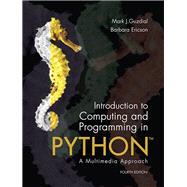NOTE: Before purchasing, check with your instructor to ensure you select the correct ISBN. Several versions of Pearson's MyLab & Mastering products exist for each title, and registrations are not transferable. To register for and use Pearson's MyLab & Mastering products, you may also need a Course ID, which your instructor will provide.
Used books, rentals, and purchases made outside of Pearson
If purchasing or renting from companies other than Pearson, the access codes for Pearson's MyLab & Mastering products may not be included, may be incorrect, or may be previously redeemed. Check with the seller before completing your purchase.
Social Computing and Programming with Python
Introduction to Computing and Programming in Python is a uniquely researched and up-to-date volume that is widely recognized for its successful introduction to the subject of Media Computation. Emphasizing creativity, classroom interaction, and in-class programming examples, Introduction to Computing and Programming in Python takes a bold and unique approach to computation that engages students and applies the subject matter to the relevancy of digital media. The Fourth Edition teaches students to program in an effort to communicate via social computing outlets, providing a unique approach that serves the interests of a broad range of students.
Personalize Learning with MyProgrammingLab®
MyProgrammingLab is an online homework, tutorial, and assessment program designed to work with this text to engage students and improve results. Within its structured environment, students practice what they learn, test their understanding, and pursue a personalized study plan that helps them better absorb course material and understand difficult concepts.
0134059840 / 9780134059846 Introduction to Computing and Programming in Python plus MyProgrammingLab with Pearson eText -- Access Card Package, 4/e
Package consists of:
- 0205891454 / 9780205891450 MyProgrammingLab with Pearson eText -- Access Card -- for Introduction to Computing and Programming in Python
- 0134025547 / 9780134025544 Introduction to Computing and Programming in Python, 4/e








